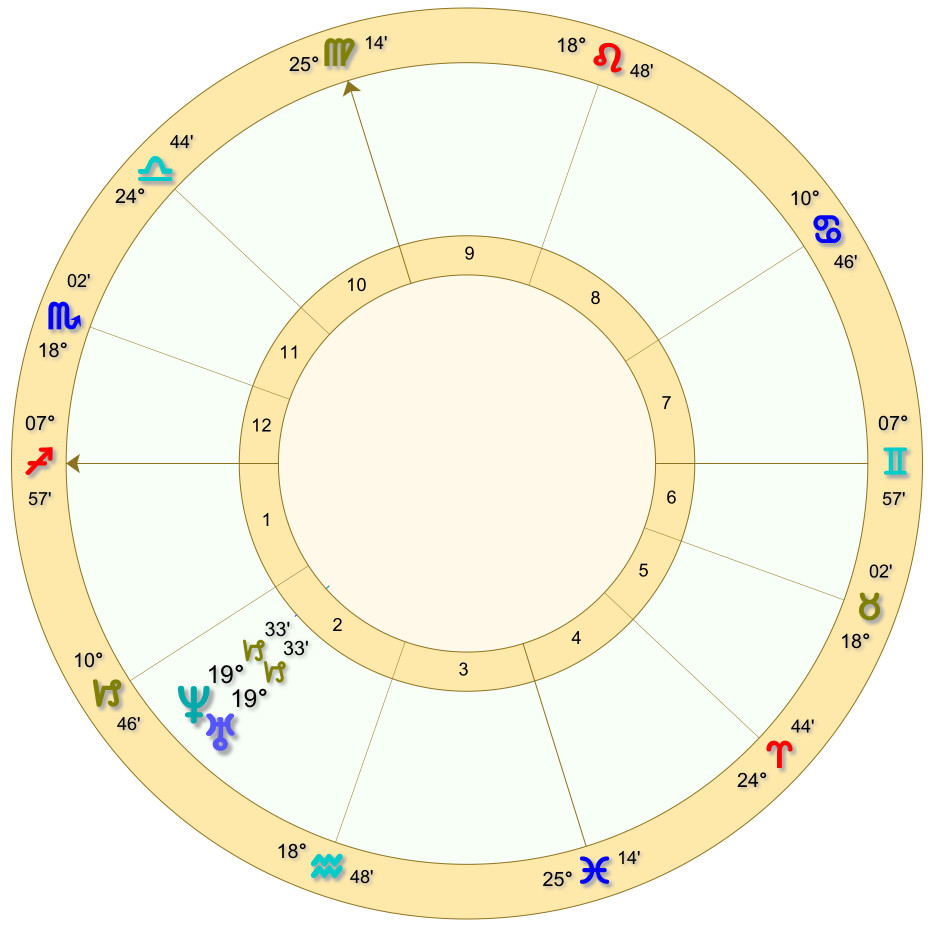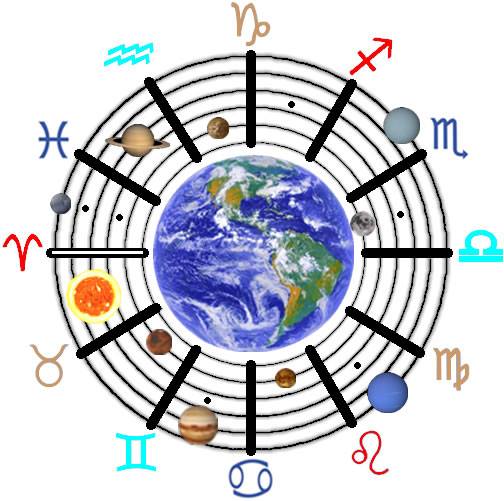Uranus Cycles
In A Century of Change: 1940-2040, we explored the Neptune-Pluto (♆ – ♇) cycle in the context of the Aquarian Age. In this post, we’ll explore the Uranus-Neptune (♅ – ♆) and Uranus-Pluto (♅ – ♇) cycles to help put this period into perspective. The shift from the Piscean Age to the Aquarian Age won’t happen overnight, but it is happening.
Though it can be challenging to consider a future that we won’t live to see, many events in this timeline will occur generations from now. It’s still comforting to know that our grandchildren may play a role in this grand new age. Those living today will have plenty of stories to pass on to their grandchildren about how they helped forge the path to a Golden Era of peace for humanity.
Uranus-Neptune Cycle

A Uranus cycle is roughly 84 years, about half of a Neptune cycle at approximately 164 years. These two planets are conjunct (♅ ☌ ♆) every 171 years, with each conjunction progressing about 15 degrees through the zodiac. When Uranus returns to the point of the last conjunction, an opposition with Neptune (♅ ☍ ♆) begins to form, usually in the same sign.
It takes two complete Uranus-Neptune cycles (342 years) for these transits to progress through each sign. In 1821AD, a ♅ ☌ ♆ transit occurred at 03° Capricorn ♑, with an opposition 85-86 years later as Uranus again transited Capricorn. The most recent ♅ ☌ ♆ transit occurred in 1992 at 18° ♑, and the next ♅ ☍ ♆ transit will happen in 2080 when Uranus reaches 01° Aquarius ♒. In 2165AD, a ♅ ☌ ♆ transit will occur in Aquarius for the first time in almost 4,000 years.
Uranus-Neptune Conjunctions: Overview

Looking at an overview of Uranus-Neptune conjunctions through the ages, a larger cycle becomes clear. Each conjunction progresses 14-17 degrees through the zodiac, with most occurring in the same sign twice in a row. Therefore, it takes 22-24 conjunctions to return to the same degree. It takes roughly 3,500-years to complete this cycle of conjunctions through the zodiac.
♅ ☌ ♆ 919BC – 2852AD
919BC= 09° ♈
747BC= 26° ♈
576BC= 14° ♉
404BC= 01° ♊
233BC= 18° ♊
62BC= 05° ♋
0110= 21° ♋
0281= 08° ♌
0452= 23° ♌
0623= 09° ♍
0794= 25° ♍
0965= 11° ♎
1136= 27° ♎
1307= 13° ♏
1478= 29° ♏
1650= 14° ♐
1821= 03° ♑
1992= 18° ♑
1993= 19° ♑
2165= 06° ♒
2336= 24° ♒
2508= 12° ♓
2680= 00° ♈
2852= 19° ♈
Uranus-Neptune: Dynamics

Uranus represents revolutionary ideals and events in history, and Neptune represents our beliefs and passion. When these two are conjunct, we can expect to find deeply compelling entertainment, exciting new paths to spiritual enlightenment, and revolutions of, by, and for the people. When Uranus and Neptune are opposed in the zodiac, we may see the darker side of this combination: new weapons development, a rise in despots and cult leaders, and an epidemic of drug overdoses. In the case of Uranus, an opposition can be a positive impetus, especially when Uranus is in the sign of Aquarius as it will be later this century in the 2080s.
Uranus-Neptune: 1136-2165AD
1136= (♅ ☌ ♆) 27° ♎
1224= (♅ ☍ ♆) 11° ♏ / ♓
1307= (♅ ☌ ♆) 13° ♏
1392= (♅ ☍ ♆) 16° ♏ / ♓
1478= (♅ ☌ ♆) 29° ♏
1565= (♅ ☍ ♆) 11° ♐ / ♊
1650= (♅ ☌ ♆) 14° ♐
1735 (Jan)= (♅ ☍ ♆) 21° ♐ / ♊
(May)= (♅ ☍ ♆) 22° ♐ / ♊
(Dec)= (♅ ☍ ♆) 24° ♐ / ♊
1736 (May)= (♅ ☍ ♆) 25° ♐ / ♊
(Dec)= (♅ ☍ ♆) 27° ♐ / ♊
1737 (July)= (♅ ☍ ♆) 29° ♐ / ♊
(Nov)= (♅ ☍ ♆) 00° ♑ / ♋
1738 (Aug)= (♅ ☍ ♆) 02° ♑ / ♋
(Oct)= (♅ ☍ ♆) 03° ♑ / ♋
1739 (Sep)= (♅ ☍ ♆) 06° ♑ / ♋
1821= (♅ ☌ ♆) 03° ♑
1906= (♅ ☍ ♆) 07° ♑ / ♋
1907 (Jan)= (♅ ☍ ♆) 07° ♑ / ♋
(Jun)= (♅ ☍ ♆) 11° ♑ / ♋
1908 (Jan)= (♅ ☍ ♆) 13° ♑ / ♋
(Jul)= (♅ ☍ ♆) 14° ♑ / ♋
(Dec)= (♅ ☍ ♆) 16° ♑ / ♋
1909 (Aug)= (♅ ☍ ♆) 17° ♑ / ♋
(Nov)= (♅ ☍ ♆) 18° ♑ / ♋
1910 (Sep)= (♅ ☍ ♆) 21° ♑ / ♋

Feb. 2, 1993: Uranus-Neptune Conjunction
1992 (Apr)= (♅ ☌ ♆) 18° ♑
1993 (Feb/Jul/Nov)= (♅ ☌ ♆) 19° ♑
(Oct)= (♅ ☌ ♆) 18° ♑
2080 (Jan)= (♅ ☍ ♆) 01° ♒ / ♌
(Aug)= (♅ ☍ ♆) 03° ♒ / ♌
2081 (Jan)= (♅ ☍ ♆) 04° ♒ / ♌
(Sep)= (♅ ☍ ♆) 06° ♒ / ♌
2082= (♅ ☍ ♆) 09° ♒ / ♌
2165= (♅ ☌ ♆) 06° ♒
Uranus-Pluto Cycle

A Uranus cycle is roughly 84 years, about one-third of a Pluto cycle at 244 years. These two planets are conjunct (♅ ☌ ♇) at odd intervals, with every other conjunction occurring in the same sign approx. 245 years apart. Though the conjunctions do not progress through the zodiac in order, they do occur in the same element for long intervals of time.
Every ♅ ☌ ♇ transit since 1343AD has occurred in Fire signs until the most recent conjunction at 17° Virgo ♍ in the year 1965. The next time Uranus transits Virgo in the late 2040s, it will oppose Pluto (♅ ☍ ♇) at 07° Pisces ♓. And the next ♅ ☌ ♇ transit occurs in the year 2104AD at 07° Taurus ♉. As the Uranus-Neptune conjunctions move from Earth to Air signs, the Uranus-Pluto conjunctions are moving from Fire to Earth.
Uranus-Pluto Conjunctions: Overview

Looking at an overview of Uranus-Pluto conjunctions through the ages, a larger cycle becomes clear. Due to Pluto’s eccentric orbit, every other conjunction is approx. 143 years apart, with the ones in between at 111-year intervals. Though we can see two conjunctions in the early degrees of Gemini about 3,000 years apart, it takes another 3,000 years to complete the zodiacal cycle following every other conjunction.
♅ ☌ ♇ 70BC – 2863AD
70BC= 01° ♊
74AD= 17° ♒
0185= 12° ♊
0328= 29° ♒
0439= 22° ♊
0582= 10° ♓
0693= 03° ♋
0836= 21° ♓
0947= 15° ♋
1090= 01° ♈
1201= 29° ♋
1343= 11° ♈
1456= 11° ♌
1597= 20° ♈
1710= 28° ♌
1851= 29° ♈
1965= 17° ♍
2104= 07° ♉
2221= 07° ♎
2357= 16° ♉
2477= 02° ♏
2610= 24° ♉
2734= 27° ♏
2863= 02° ♊
Uranus-Pluto: Dynamics

Uranus represents revolutionary ideals and events in history, and Pluto represents death and rebirth and the depths of our experience. Both of these planets are extremely volatile, making it difficult to portray their influence as either positive or negative. Therefore, the conjunctions and oppositions between Uranus and Pluto can be perceived very differently. Despite our subjective experience, when these two planets interact we see major upheavals, secrets unearthed, and catastrophic events of all kinds.
Though we cannot count on the conjunctions to deliver the best of these planets, the sextiles and trines often do. We’re currently entering a rare Uranus-Pluto trine in Air Signs. With Uranus in Gemini and Pluto in Aquarius we can expect revolutionary new ideas to level the playing field, knocking down outdated hierarchies, and leaving the people in control of their own destinies. Modern technologies will play a pivitol role in changing the game once and for all. We finally have the power to create a global direct democracy at our fingertips, and we’re ready to knock down any obstacles in our path.
Uranus-Pluto: 947 – 2104AD
0947= (♅ ☌ ♇) 15° ♋
1028= (♅ ☍ ♇) 07° ♋ / ♑
1090= (♅ ☌ ♇) 01° ♈
1141= (♅ ☍ ♇) 19° ♏ / ♉
1201= (♅ ☌ ♇) 29° ♋
1284= (♅ ☍ ♇) 25° ♋ / ♑
1343= (♅ ☌ ♇) 11° ♈
1396= (♅ ☍ ♇) 01° ♊ / ♐
1456= (♅ ☌ ♇) 11° ♌
1539= (♅ ☍ ♇) 10° ♌ / ♒
1597= (♅ ☌ ♇) 20° ♈
1649= (♅ ☍ ♇) 10° ♐ / ♊
1710= (♅ ☌ ♇) 28° ♌
1792= (♅ ☍ ♇) 21° ♌ / ♒
1851= (♅ ☌ ♇) 29° ♈
1902= (♅ ☍ ♇) 19° ♐ / ♊
1965= (♅ ☌ ♇) 17° ♍
2048= (♅ ☍ ♇) 07° ♍ / ♓
2104= (♅ ☌ ♇) 07° ♉

Oct. 10, 1965: Uranus-Pluto Conjunction
The Aquarian Age Series continues…
The Age of Aquarius will continue from now until about 4200AD, when the Age of Capricorn begins. As Pluto enters Aquarius, Uranus approaches Gemini, and Neptune moves closer to Aries, the stage is being set for a major event like we’ve never seen before. A rare alignment between the outer planets will open a window in time, allowing humanity to achieve what thousands of generations were unable to do. Not for lack of trying, and many have fought and died for the principles we’ll begin to implement. In the Aquarian Age Blog and Podcast series, we’ll continue to explore this decade and beyond.
Special Thanks for images from:

